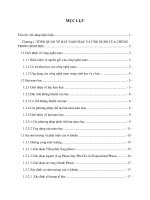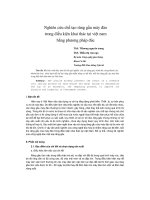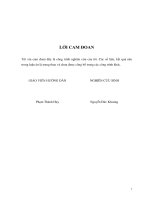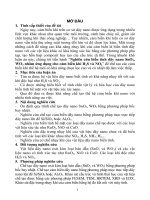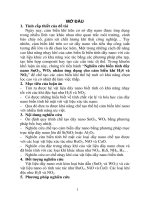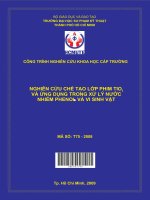Nghiên cứu chế tạo sợi nano fe2o3 và znfe2o4 lai graphene khử từ ôxit graphene (RGO) bằng phương pháp phun tĩnh điện và ứng dụng cho cảm biến khí h2s
Bạn đang xem bản rút gọn của tài liệu. Xem và tải ngay bản đầy đủ của tài liệu tại đây (9.8 MB, 141 trang )
MINISTRY OF EDUCATION AND TRAINING
HANOI UNIVERSITY OF SCIENCE AND TECHNOLOGY
Nguyen Van Hoang
ELECTROSPINNING OF α-Fe2O3 AND ZnFe2O4 NANOFIBERS
LOADED WITH REDUCED GRAPHENE OXIDE (RGO)
FOR H2S GAS SENSING APPLICATION
DOCTORAL DISSERTATION OF MATERIALS SCIENCE
Hanoi – 2020
MINISTRY OF EDUCATION AND TRAINING
HANOI UNIVERSITY OF SCIENCE AND TECHNOLOGY
Nguyen Van Hoang
ELECTROSPINNING OF α-Fe2O3 AND ZnFe2O4 NANOFIBERS
LOADED WITH REDUCED GRAPHENE OXIDE (RGO)
FOR H2S GAS SENSING APPLICATION
Major: Materials Science
Code: 9440122
DOCTORAL DISSERTATION OF MATERIALS SCIENCE
SUPERVISOR: PROF. PhD. NGUYEN VAN HIEU
Hanoi – 2020
DECLARATION OF AUTHORSHIP
This dissertation has been written in the basic of my researches carried out at
Hanoi University of Science and Technology, under the supervision of Prof. PhD.
Nguyen Van Hieu. All the data and results in the thesis are true and were agreed to
use in my thesis by co-authors. The presented results have never been published by
others.
.
Hanoi, 16th January 2020
Supervisor
Prof. PhD. Nguyen Van Hieu
PhD. Student
Nguyen Van Hoang
ACKNOWLEDGMENTS
First, I would like to express my deep gratitude to my supervisor, Prof. Nguyen
Van Hieu, for his devotion and inspiring supervision. I would like to thank him for
all his advice, support and encouragement throughout my postgraduate course.
I am grateful to Assoc. Prof. PhD. Nguyen Duc Hoa, Assoc. Prof. PhD. Nguyen
Van Duy, PhD. Dang Thi Thanh Le, PhD. Chu Manh Hung, and PhD. Nguyen Van
Toan for their useful help, suggestions and comments. I also would like to express
my special thanks to PhD and Master Students at iSensors Group for their support
and shared cozy working environment during my PhD course.
I am thankful to the leaders and staffs of International Training Institute for
Materials Science (ITIMS), Graduate School for their help and given favorable
working conditions.
I would like to thank my colleagues at Department of Materials Science and
Engineering at Le Quy Don Technical University for their support during my PhD
course.
I gratefully acknowledge the fund from Vietnam National Foundation for Science
and Technology Development (NAFOSTED) under code 103.02-2017.25 and the
911 Scholarship of Ministry of Education and Training for the financial support for
my research.
Last but not least, I am deeply thankful to my family for their endless love and
unconditional support. Without them, the work would have been impossible.
PhD. Student
Nguyen Van Hoang
CONTENTS
CONTENTS ................................................................................................................ i
ABBREVIATIONS AND SYMBOLS ...................................................................... v
LIST OF TABLES ................................................................................................... vii
LIST OF FIGURES ................................................................................................. viii
INTRODUCTION ...................................................................................................... 1
CHAPTER 1. OVERVIEW ON SMO NFs AND THEIR LOADING WITH RGO
FOR GAS-SENSING APPLICATION ...................................................................... 6
1.1.
Electrospinning for NFs fabrication.............................................................. 6
1.1.1.
Background on electrospinning.............................................................. 6
1.1.2.
Processing – structure relationships of electrospun NFs ....................... 7
1.2.
NFs for gas-sensing application .................................................................. 10
1.2.1.
Electrospun SMO NFs for gas-sensing application ............................. 10
1.2.2.
Electrospun SMO NFs for H2S gas-sensing application ...................... 13
1.3.
1.2.2.1.
H2S gas .......................................................................................... 13
1.2.2.2.
Electrospun SMO NFs for H2S gas-sensing application ............... 13
NFs loading with RGO for gas-sensing application ................................... 14
1.3.1.
Overview on RGO and its application in gas-sensing field ................. 14
1.3.1.1.
Overview on RGO ......................................................................... 14
1.3.1.2.
RGO in gas-sensing application .................................................... 17
1.3.2.
RGO-loaded SMO NFs in gas-sensing applications ............................ 19
1.3.2.1.
RGO-loaded SMO gas sensor ....................................................... 19
1.3.2.2.
RGO-loaded SMO NFs gas sensor ................................................ 22
i
1.4.
Gas-sensing mechanism .............................................................................. 24
1.4.1.
Gas-sensing mechanism of SMO NFs ................................................. 24
1.4.2.
Gas-sensing mechanism of RGO-loaded SMO NFs ............................ 25
1.4.3.
H2S gas-sensing mechanism of SMO NFs and their loading with
RGO….. ............................................................................................................. 27
Conclusion of chapter 1 ............................................................................................ 28
CHAPTER 2. EXPERIMENTAL APPROACH ...................................................... 29
2.1.
Synthesis ..................................................................................................... 29
2.1.1.
RGO preparation .................................................................................. 29
2.1.2.
α-Fe2O3 NFs preparation ...................................................................... 30
2.1.3.
ZFO NFs preparation ........................................................................... 31
2.1.4.
Preparation of α-Fe2O3, ZFO NFs loading with RGO ......................... 32
2.2.
Characterization Techniques ....................................................................... 32
2.2.1.
Raman spectroscopy............................................................................. 32
2.2.2.
Thermal analysis .................................................................................. 33
2.2.3.
X-ray diffraction................................................................................... 33
2.2.4.
SEM and EDX ...................................................................................... 34
2.2.5.
TEM and SAED ................................................................................... 34
2.3.
Gas-sensing measurement ........................................................................... 35
Conclusion of chapter 2 ............................................................................................ 36
CHAPTER 3. α-Fe2O3 NFs AND THEIR LOADING WITH RGO FOR H2S GASSENSING APPLICATION ...................................................................................... 37
3.1.
Introduction ................................................................................................. 37
3.2.
H2S gas sensors based on α-Fe2O3 NFs ...................................................... 39
3.2.1.
Morphologies and structures of α-Fe2O3 NFs ...................................... 39
ii
3.2.2.
3.3.
H2S gas-sensing properties of α-Fe2O3 NFs sensors ............................ 46
3.2.2.1.
Effects of operating temperature ................................................... 46
3.2.2.2.
Effects of solution contents ........................................................... 48
3.2.2.3.
Effects of annealing temperature and electrospinning time .......... 50
3.2.2.4.
Selectivity and stability ................................................................. 53
H2S gas sensors based on α-Fe2O3 NFs loaded with RGO ......................... 54
3.3.1.
Morphologies and structures of α-Fe2O3 NFs loaded with RGO ......... 54
3.3.2.
H2S gas-sensing properties of RGO-loaded α-Fe2O3 NFs sensors ...... 58
3.3.2.1.
Effects of RGO contents................................................................ 58
3.3.2.2.
Effects of working temperature ..................................................... 61
3.3.2.3.
Effects of annealing temperatures ................................................. 62
3.3.2.4.
Selectivity and stability ................................................................. 64
Conclusion of chapter 3 ............................................................................................ 65
CHAPTER 4. ZFO NFs AND THEIR LOADING WITH RGO FOR H2S GASSENSING APPLICATION ...................................................................................... 66
4.1.
Introduction ................................................................................................. 66
4.2.
H2S gas sensors based on ZFO NFs ............................................................ 68
4.2.1.
Microstructure characterization ........................................................... 68
4.2.2.
Gas-sensing properties ......................................................................... 74
4.3.
4.2.2.1.
Effects of the operating temperature ............................................. 74
4.2.2.2.
Effects of the annealing temperature ............................................. 76
4.2.2.3.
Effects of annealing time and heating rate .................................... 79
4.2.2.4.
Selectivity and stability ................................................................. 81
H2S gas sensors based on ZFO NFs loaded with RGO .............................. 82
4.3.1.
Microstructure characterization ........................................................... 82
iii
4.3.2.
Gas-sensing properties ......................................................................... 86
4.3.2.1.
Effects of RGO contents................................................................ 86
4.3.2.2.
Effects of operating temperature ................................................... 88
4.3.2.3.
Effects of annealing temperatures ................................................. 89
4.3.2.4.
Selectivity, stability and RH effects .............................................. 91
Conclusion of chapter 4 ............................................................................................ 94
CONCLUSIONS AND RECOMMENDATIONS ................................................... 95
LIST OF PUBLICATIONS ...................................................................................... 97
REFERENCES ......................................................................................................... 98
APPENDIX ............................................................................................................ 117
iv
ABBREVIATIONS AND SYMBOLS
Number
Meaning
1
Abbreviations and
symbols
1D
2
2D
Two Dimension
3
CVD
Chemical Vapor Deposition
4
DI
Deionized Water
5
DL
Detection Limit
6
DMF
Dimethylformamide
7
DTG
Derivative Thermogravimetric
8
EDX
9
FE-SEM
10
FFT
Energy Dispersive X-ray spectroscopy
Field Emission Scanning Electron
Microscope
Fast Fourier Transform
11
GO
Graphene Oxides
12
GP
13
HRTEM
14
IUPAC
15
JCPDS
16
NFs
Graphene
High Resolution Transmission Electron
Microscope
International Union of Pure and Applied
Chemistry
Joint Committee on Powder Diffraction
Standards
Nanofibers
17
NPs
Nanoparticles
18
NRs
Nanorods
19
NSs
Nanosheets
20
NTs
Nanotubes
21
NWs
Nanowires
22
ppb
Parts Per Billion
23
ppm
Parts Per Million
24
PVA
Poly(vinyl alcohol)
25
RGO
Reduced Graphene Oxides
26
RH
Ambient Relative Humidity
27
RT
Room Temperature
One Dimension
v
28
SAED
Selected Area Electron Diffraction
29
sccm
Standard Cubic Centimeters Per Minute
30
SEM
Scanning Electron Microscope
31
SMO
Semiconductor Metal Oxides
32
TEM
Transmission Electron Microscope
33
TGA
Thermogravimetric Analysis
34
WF
Work Function
35
XRD
X-ray Diffraction
36
ZFO
Zinc Ferrite, ZnFe2O4
37
Ra
Sensor resistance in dry air
38
Rg
Sensor resistance in tested gas
39
S
Sensor Response
40
τres
Response time
41
τrec
Recovery time
vi
LIST OF TABLES
Table 1.1. SMO NFs for gas-sensing application .................................................... 12
Table 2.1. Processing parameter of of α-Fe2O3 NFs, ZFO NFs and their loading
with RGO .................................................................................................................. 31
Table 3.1. Different nanostructures of α-Fe2O3 for H2S gas-sensing application ... 38
Table 3.2. α-Fe2O3 loaded with RGO for gas-sensing application .......................... 38
Table 4.1. Different nanostructures of ZFO for H2S gas-sensing application ......... 67
Table 4.2. Comparison of the H2S gas sensitivity of the sensor based on other
nanomaterials and nanostructures............................................................................. 93
Table A3.1. Calculation table of DL to H2S of sensors based on α-Fe2O3 NFs loaded
with different contents of RGO from 0 to 1.5 wt% RGO at 350°C. ...................... 117
Table A3.2. Calculation table of DL to H2S of α-Fe2O3 NFs sensors calcined at
annealing temperatures from 400°C to 800°C at 350°C. ...................................... 118
Table A3.3. Calculation table of DL to H2S of 1.0 wt.% RGO-loaded α-Fe2O3 NFs
sensors calcined at annealing temperatures from 400°C to 800°C at 350°C. ........ 119
Table A4.1. Average nanograin sizes determined by Scherrer formula and
integrated intensity of (311) diffraction peak of ZFO-NFs calcined at different
conditions................................................................................................................ 120
Table A4.2. Response and response-recovery time to 1 ppm H2S gas at the
operating temperature of 350°C of the ZFO NFs sensors calcined at different
annealing temperatures (400−700°C), annealing time (0.5−48 h), heating rates
(0.5−20°C/min), electrospinning time (10−120 min)............................................. 121
Table A4.3. Calculation table of DL to H2S of the ZFO NFs sensors calcined at the
annealing temperature from 400°C to 700°C at 350°C. ......................................... 122
Table A4.4. Calculation table of DL to H2S of the 1 wt% RGO-loaded ZFO NFs
sensors calcined at annealing temperatures from 400°C to 700°C at 350°C. ........ 123
vii
LIST OF FIGURES
Figure 1.1: Schematic diagram of electrospinning method: 1-Collector, 2-As-spun
fibers, 3-Precursor solution, 4- Syringe, 5-Needle, 6- DC voltage power supply. .... 7
Figure 1.2. Kind of collectors and needles: (a) plate collector (b) Multiple
spinnerets (c) Coaxial spinneret (d) Bicomponent spinneret (e) Disc collector , (d)
Rotating drum [33]. .................................................................................................... 8
Figure 1.3. FESEM images of ZnO NFs (a) as-spun, (b) calcined at 600°C in air.10
Figure 1.4. Number of annual publications on “graphene” and “graphene and
sensors” according to Scopus Database. The dashed lines are exponential fitting of
the number of publications. Inset is where “graphene and sensors” publications have
appeared [64]. ........................................................................................................... 15
Figure 1.5. Scotch –tape method [65]...................................................................... 16
Figure 1.6. Histogram detailing the number of graphene-based gas/vapor sensors
publications per year for the period from 2007 to 2014 (data obtained from ISI Web
of Knowledge, January 28, 2015) ) [72]................................................................... 17
Figure 1.7. (a) RGO device (b) SEM image of a sensing device composed of RGO
platelets that bridge neighboring Au fingers, Representative dynamic behavior of
RGO sensors for (c) 100 ppm NO2 and (d) 1% NH3 detection [74]. ....................... 18
Figure 1.8. (a) Schematic of the novel gas-sensing platform of an RGO sheet
decorated with SnO2 nanocrystal. (b) Schematic of the sensor testing system [83]. 20
Figure. 1.9. SEM and TEM images of (a,b) RGO-loaded ZnO NFs and (c-d) RGOloaded SnO2; Sensor response of (e) RGO-loaded ZnO NFs and (f) RGO-loaded
SnO2; (g) Comparision of of pure SnO2 NFs, pure ZnO NFs, rGO-loaded SnO2 NFs
and rGO-loaded ZnO NFs to 10 ppm H2 gas [91]. ................................................... 22
Figure 1.10. Schematic illustration of sensing mechanism of pure n-ZnO NFs
[11,180]..................................................................................................................... 25
Figure 1.11. Schematic illustration of sensing mechanism of RGO-loaded ZnO NFs
[11]............................................................................................................................ 26
viii
Figure 1.12. Schematic illustration of sensing mechanisms with respect to NO2 gas
RGO-loaded SnO2 NFs [94]. .................................................................................... 27
Figure 2.1. (a) Schematic of on-chip fabrication of NF sensors by electrospinning:
(1) collector, (2) Pt electrodes, (3) DC high voltage power supply, (4) as-spun
nanofibers, (5) needle, (6) syringe; (b-d) FESEM images of on-chip NFs. ............. 30
Figure 2.2. Schematic diagram of the gas-sensing system [113]. ........................... 35
Figure 3.1. Crystal structure of α-Fe2O3 [119]......................................................... 37
Figure 3.2. TGA curve for decomposition of as-spun α-Fe2O3 fibers ..................... 39
Figure 3.3. XRD patterns of as-spun fibers and α-Fe2O3 NFs calcined calcined at
different annealing temperatures (400 − 800°C) for 3 h in air. ................................ 40
Figure 3.4. FESEM images of as-spun and α-Fe2O3 NFs prepared with various PVA
concentrations: 7 (a, d), 11 (b, e), and 15 wt% (c, f), respectively. Insets are lowmagnification images. ............................................................................................... 41
Figure 3.5. FESEM images of as-spun and α-Fe2O3 NFs prepared with different
ferric salt concentrations: 2 wt% (a, d), 4 wt% (b, e), and 8 wt% (c, f), respectively.
Insets are low-magnification images. ....................................................................... 42
Figure 3.6. FESEM images of the α-Fe2O3 NFs sensors prepared at electrospun
time of 10 (a), 30 (b), 60 (c), and 120 min (d). ........................................................ 43
Figure 3.7. FESEM images of as-spun fibers (a) and α-Fe2O3 NFs prepared at
different annealing temperatures: 400°C (b), 500°C (c), 600°C (d), 700°C (e), and
800°C (f). Inset figures are low-magnification images. ........................................... 44
Figure 3.8. TEM images at different magnifications (a-b), HRTEM image (c) with
corresponding fast Fourier transform (FFT) inset image, and EDX spectrum (d) of
α-Fe2O3 NFs calcined at 600°C for 3 h in air. .......................................................... 46
Figure 3.9. Sensing transients of α-Fe2O3 NF sensors to 1 ppm H2S at various
operating temperatures (a), sensor resistances (b), sensor response (c), response time
and recovery time (d) as a function of operating temperatures. ............................... 47
Figure. 3.10. Schematic of the gas-sensing mechanism of the α-Fe2O3 NFs: in air (a)
and in H2S gas (b). .................................................................................................... 48
ix
Figure 3.11. H2S sensing transients of α-Fe2O3 NF sensors with various PVA
concentrations (a−c) and different ferric salt concentrations (d−f). Sensor response
to H2S gas as a function of PVA concentrations (g) and ferric salt concentrations (h).
.................................................................................................................................. 50
Figure 3.12. H2S sensing transients of α-Fe2O3 NF sensors with various annealing
temperatures (400−800°C) (a−e) and different electrospinning time (10−120 min)
(e−h). Sensor response to H2S gas as a function of annealing temperatures (i) and
electrospinning time (k). ........................................................................................... 51
Figure 3.13. Selectivity to various gases at 350°C (a) and stability at 1 ppm H2S gas
at 350°C (b) of the sensors based on α-Fe2O3 NFs calcined at 600°C. .................... 53
Figure 3.14. XRD patterns (a), Raman spectrum (b) SEM image (c) and TGA
curves (d) of synthesized RGO................................................................................. 54
Figure 3.15. FESEM images of the α-Fe2O3 NFs loaded by RGO of various
concentrations: 0 (a), 0.5 (b), 1.0 (c), and 1.5 wt% (d). ........................................... 55
Figure 3.16. FESEM images of 1.0 wt% RGO loaded α-Fe2O3: as-spun (a) and
calcined at 400 (b), 500 (c), 600 (d), 700 (e), and 800°C (f) for 3 h in air. ............. 56
Figure 3.17. XRD patterns (a) and EDX spectrum (b) of α-Fe2O3 NFs annealed at
600°C for 3 h in air. .................................................................................................. 57
Figure 3.18. TEM images at different magnifications (a-b), SAED pattern (c), and
HRTEM image (d) with corresponding fast Fourier transform (FFT) inset image of
1%wt RGO loaded α-Fe2O3 annealed at 600°C for 3 hours in air. .......................... 58
Figure 3.19. H2S sensing transients of α-Fe2O3 NFs sensors loaded with different
RGO concentrations: 0 (a), 0.5 (b) 1.0 (c) and 1.5 wt% (d). Sensor resistance (e),
gas response (f), and response time and recovery time (g) as a function of RGO
concentrations at working temperature of 350°C. .................................................... 59
Figure 3.20. Schematic of the proposed H2S sensing mechanism of RGO-loaded
NFs; band diagram of RGO and SMO (a) at equilibrium (b) in air exposure (c) and
in H2S gas exposure (d). ........................................................................................... 61
Figure 3.21. Sensing transients of 1.0 wt% RGO loaded α-Fe2O3 NF sensors to 1
ppm H2S at various operating temperatures (a), sensor resistances (b), sensor
x
response (c), response time and recovery time (d) as a function of operating
temperatures.............................................................................................................. 62
Figure 3.22. H2S sensing transients of sensors based on α-Fe2O3 NFs loaded 1.0
wt% RGO with different annealing temperatures 400 (a), 500 (b), 600 (c), 700 (d)
and 800°C (e). Gas response to H2S various concentrations (f) of sensors based on
α-Fe2O3 NFs loaded 1.0 wt% RGO as a function of annealing temperatures at
working temperatures of 350°C. .............................................................................. 63
Figure 3.23. Short-term stability at 1 ppm H2S gas at 350°C (a) and selectivity to
various gases at 350°C (b) of the sensors based on 1%wt RGO loaded α-Fe2O3 NFs
calcined at 600°C. ..................................................................................................... 64
Figure 3.24. Comparative selectivity of sensors based on α-Fe2O3 NFs and 1%wt
RGO loaded α-Fe2O3 NFs to various gases at 350°C. .............................................. 64
Figure 4.1. Crystal structure of ZFO [181]. ............................................................. 66
Figure. 4.2. TGA curve for the decomposition of the as-spun fibers of ZFO. . Error!
Bookmark not defined.
Figure 4.3. XRD patterns, average grain sizes and integrated intensity of the (311)
diffraction peaks of ZFO-NFs calcined at different annealing temperatures (a, d),
annealing time (b, e), and heating rates (c, f). Insets are profiles of (311) Bragg.
diffractions. ............................................................................................................... 69
Figure 4.4. FE-SEM images of as-electrospun ZFO precursor fibers (a) and ZFONFs calcined at 400°C (b), 500°C (c), 600°C (d), and 700°C (e) for 3 h in air; EDX
spectrum of ZFO-NFs calcined at 600°C for 3 h in air (f). ...................................... 70
Figure. 4.5. FESEM images of ZFO-NFs calcined at various annealing time:
0.5 (a), 3 (b), 12 (c), and 48 h (d). ............................................................................ 71
Figure. 4.6. FESEM images of ZFO-NFs calcined at various heating rates:
0.5 (a), 2 (b), 5 (c), and 20°C/min (d). ..................................................................... 72
Figure 4.7. TEM images at different magnifications (a-b), SAED pattern (c), and
HRTEM image (d) with corresponding fast Fourier transform (FFT) inset image of
ZFO-NFs calcined at 600°C for 3 h in air. ............................................................... 73
xi
Figure 4.8. The transients of the ZFO NFs sensors to 1 ppm H2S at various
operating temperatures (a); sensor response (b), sensor resistances (c), response
time and recovery time (d) as a function of the operating temperatures. ................. 75
Figure 4.9. H2S sensing transients of the ZFO-NF sensors calcined at different
temperatures (400–700°C) measured at 350°C (a–d). Gas response as functions of
H2S gas concentration at 350°C (e). Gas response (f), DL (g), response time and
recovery time (h) as a function of the annealing temperature. ................................. 78
Figure 4.10. Response at working temperature of 350°C as a function of H2S
concentration for different annealing time (a) and heating rate (d). Response and
response-recovery time as a function of annealing time (b, c) and heating rate (e, f).
.................................................................................................................................. 79
Figure 4.11. Selectivity to various gases at 350°C (a) and stability at 1 ppm H2S gas
at 350°C (b) of the sensors based on ZFO NFs calcined at 600°C. ......................... 80
Figure 4.12. Comparative selectivity of ZFO NFs-based sensors and α-Fe2O3-based
NFs sensors to various gases at 350°C. .................................................................... 81
Figure 4.13. FESEM images of the ZnFe2O4 NFs loaded by RGO of various
concentrations: 0 (a), 0.5 (b), 1 (c), and 1.5 wt% (d). .............................................. 83
Figure 4.14. FESEM images of 1%wt RGO loaded ZFO NFs calcined at 400°C (a),
500°C (b), 600°C (c), and 700°C (d) for 3 h in air. .................................................. 84
Figure 4.15. XRD patterns (a) and EDX spectrum (b) of 1%wt RGO-loaded ZFO
NFs annealed at 600oC for 3 h in air. ....................................................................... 84
Figure 4.16. TEM images at different magnifications (a-b), SAED pattern (c), and
HRTEM image (d) with corresponding fast Fourier transform (FFT) inset image of
1%wt RGO-loaded ZFO NFs annealed at 600°C for 3 hours in air. ....................... 85
Figure 4.17. H2S sensing transients of ZFO NFs sensors loaded with different RGO
concentrations: 0 (a), 0.5 (b), 1.0 (c), and 1.5 wt% (d). Gas response (e), sensor
resistance (f) and response time and recovery time (g) as a function of RGO
concentrations at the working temperature of 350°C. .............................................. 86
xii
Figure 4.18. Sensing transients of 1% wt RGO-loaded ZFO NFs sensors to 1 ppm
H2S at various operating temperatures (a), sensor resistances (b), sensor response (c),
response time (d) and recovery time (e) as a function of operating temperatures. .. 87
Figure 4.19. H2S sensing transients of sensor based on ZFO NFs loaded with 1.0
wt% RGO with different annealing temperatures 400 (a), 500 (b), 600 (c), and
700°C (d). Gas response (e), sensor resistance (f), and response time and recovery
time (g) as a function of annealing temperatures at the working temperature of
350°C. ....................................................................................................................... 88
Figure 4.20. Comparison of response (a), change level of response (b), detection
limit (DL) (c) and response-recovery time (d) of bare-ZFO and 1%wt RGO loaded
ZFO NFs sensors to 1 ppm H2S gas at 350°C as a function of annealing
temperatures.............................................................................................................. 90
Figure 4.21. Stability with 1 ppm H2S gas at 350°C (a) and selectivity to various
gases at 350°C (b) of the sensors based on the 1 wt% loaded ZFO NFs calcined at
600°C. ....................................................................................................................... 91
Figure. 4.22. Comparative selectivity of sensors based on α-Fe2O3 NFs and 1%wt
RGO loaded ZFO NFs to various gases at 350°C. ................................................... 92
Figure 4.23. The transient response (a) and sensor response (b) of the 1 wt% RGOloaded ZFO NFs sensors to 1 ppm H2S at the working temperature of ................... 92
350°C at various RH values. .................................................................................... 92
Figure A3.1. Fitted values of RSS and slope for DL calculation of sensors based on
α-Fe2O3 NFs loaded with different contents of RGO of 0 (a, e), 0.5 (b, f), 1.0 (c, g),
and 1.5 wt.% (d, h), respectively. The sensors are tested with H2S gas at operating
temperature of 350°C. ............................................................................................ 117
Figure A3.2. Fitted values of RSS and slope for DL calculation of α-Fe2O3 NFs
sensors calcined at various annealing temperatures of 400 (a, f), 500 (b, g), 600 (c,
h), 700 (d, i), and 800°C (e, j), respectively. The sensors are tested with H2S gas 118
at operating temperature of 350°C. ........................................................................ 118
Figure A3.3. Fitted values of RSS and slope for DL calculation of 1.0 wt.% RGOloaded α-Fe2O3 NFs sensors calcined at various annealing temperatures of 400 (a, f),
xiii
500 (b, g), 600 (c, h), 700 (d, i), and 800°C (e, j), respectively. The sensors are
tested with H2S gas at operating temperature of 350°C. ........................................ 119
Figure. A4.1. Fitted values of RSS and slope for DL calculation of the sensors
based on ZFO NFs calcined at various annealing temperatures of 400 (a,e), 500 (b,f),
600 (c,g), and 700°C (d,h), respectively. The sensors are tested with H2S gas at the
operating temperature of 350°C. ............................................................................ 122
Figure A4.2. Fitted values of RSS and slope for DL calculation of the sensors based
on 1 wt% RGO loaded ZFO NFs calcined at various annealing temperatures of 400
(a,e), 500 (b,f), 600 (c,g), and 700°C (d,h), respectively. The sensors are tested with
H2S gas at the operating temperature of 350°C. ..................................................... 123
xiv
INTRODUCTION
1. Background
Recently, one dimension (1D) nanostructures including nanowires (NWs),
nanorods (NRs), nanotubes (NTs), and nanofibers (NFs) have attracted much
attention for a wide application including optical catalysis, electronic devices,
optoelectronic devices, storage devices, and gas sensors due to their high surface-tovolume ratio [1]. Especially, NFs are used in many fields such as catalysis, sensor,
and energy storage because of their outstanding properties like large surface area-tovolume ratio and flexible surface functionalities [1,2]. There are several approaches
for NFs fabrication, for example, drawing, template, phase separation, selfassembly, and electrospinning [3–5], among which electrospinning is a simple, costeffective and versatile method for NFs production [1,3–6].
Regarding gas-sensing applications, semiconductor metal oxides (SMO) NFs
sensors have a lot of promise due to their advantages of SMO materials, e.g. low
cost, simple fabrication, and high compatibility with microelectronic processing [7–
10]. Furthermore, NFs consist of many nanograins, therefore, grain boundaries are
large, surface-to-volume ratio is very high, and gases easily diffuse along grain
boundaries. As a result, an exceptionally high response was observed in SMO NFs
gas sensors by electrospinning [11,12]. Among various SMO NFs prepared by
electrospinning, α-Fe2O3 has become a potential gas-sensing material because of its
low cost and thermal stability and ability to detect many gases such as NO2, NH3,
H2S, H2, and CO [13,14]. Besides, zinc ferrite ZnFe2O4 (ZFO), a Fe2O3-based
ternary spinel compounds, has been a promising material for detecting gases thanks
to its good chemical and thermal stability, low toxicity, high specific surface area
and excellent selectivity [15–18]. Otherwise, H2S is a colorless, corrosive,
inflammable and extremely toxic gas which can be rapidly absorbed by human
lungs and easily causes diseases in respiratory and nervous system, even deaths
[19–21]. However, until now, very few studies on H2S gas-sensing properties of α1
Fe2O3 and ZFO NFs, especially effects of fabrication parameters (i.e. solution
composition, heat treatment, and electrospun time) on morphology, structure and
H2S gas-sensing properties have been carried out although there have been some
reports about H2S gas sensitivity of α-Fe2O3 or ZFO with other nanostructures (e.g.
micro-ellipsoids [22], nanochains [23], porous nanospheres [24], and porous
nanosheets (NSs) [25]).
Furthermore, reduced graphene oxides (RGO), a type of GP reduced from GO
produced from graphite by Hummer method [26], has recently received world-wide
attention owing to its exceptional physicochemical properties [27,28]. The
combination between SMO NFs and RGO to enhance gas-sensing performance
through the formation of heterojunction was mentioned in many works [8,11,29].
For instance, the RGO-loaded ZnO NFs sensors showed a bell-shaped behaviour
response to NO2 gas for different weight ratios of RGO (0–1.04%) [11]. The sensor
containing 0.44 wt% RGO showed the highest response to 5 ppm NO2 at 400°C,
higher than that of pure ZnO NFs. Enhanced gas-sensing properties by
heterojunction between RGO and SMO NFs of the RGO-loaded α-Fe2O3 and ZFO
have also mentioned [30,31]. For instance, Zhang et al. [32] stated that the
composite containing 1.0 wt% RGO exhibited an enhanced gas response of 13.9 to
100 ppm acetone at the operating temperature of 225°C, which was approximately
2.5-fold as high as that of pure α-Fe2O3 (5.5). Guo et al. [30] reported that the
response of α-Fe2O3 NFs loaded with 1.0 wt% RGO to 100 ppm acetone at
operating temperature of 375°C was about 8.9 (4.5 times higher than that of pure αFe2O3). Liu et al. [31] mentioned that the response of the 0.125 wt% RGO-loaded
ZFO composite to 1000 ppm acetone at 275°C was higher than that of the bare ZFO
sensor. However, up to present, there have been no reports on the loading of RGO
in α-Fe2O3 and ZFO NFs for enhanced H2S gas-sensing performance.
Therefore, the thesis titled “Electrospinning of α-Fe2O3 and ZnFe2O4 nanofibers
loaded with reduced graphene oxide (RGO) for H2S gas sensing application” was
carried out to answer the concerns mentioned above.
2. The study objective
The study objectives of the thesis are listed as follows:
2
-
To successfully fabricate sensor based on α-Fe2O3, ZFO NFs and their loading
with RGO by on-chip electrospinning method.
-
To explore the effect of fabrication parameters (i.e. solution composition, heat
treatment, electrospun time, and RGO concentration) on the NF morphology,
structure and H2S gas sensing properties.
-
To clarify H2S gas-sensing mechanism of the sensors of α-Fe2O3, ZFO NFs and
their incorporation with RGO.
3. Research scope and content
The thesis uses α-Fe2O3, ZFO NFs, and their loading with RGO, as well as
harmful gas H2S as object studies.
The study focuses on the following contents:
-
To optimize some processing parameters (i.e. solution composition, heat
treatment, electrospun time, and RGO concentration) for on-chip sensor
fabrication of α-Fe2O3, ZFO NFs and their loading with RGO via electrospinning
method.
-
To characterize the NFs and to analyze the relationship between their
morphology and microstructure of NFs with fabrication parameters.
-
To examine H2S gas-sensing properties of the NFs sensors for clarifying the
relationship among morphology, microstructure with gas-sensing properties of
the NFs sensors.
-
To understand the H2S gas-sensing mechanisms of α-Fe2O3, ZFO NFs and their
loading with RGO.
4. Research methodology
To achieve the objectives, the thesis research was conducted by experimental
methods, namely:
-
The on-chip electrospinning method was employed for the fabrication of αFe2O3, ZFO NFs and their loading with RGO.
-
Morphology and structure of the NFs were characterized by TGA, RAMAN,
FE-SEM, TEM, HR-TEM, SAED, EDX, and XRD.
-
The gas-sensing properties of the NFs were measured by a home-made system
using flow-through technique.
3
5. Scientific and practical relevance of the dissertation
The scientific relevance: The thesis results elaborated the relationship among
processing parameters, microstructure, and gas-sensing properties of α-Fe2O3, ZFO
NFs and their loading with RGO. In addition, the thesis also clarified H2S gassensing mechanisms of α-Fe2O3, ZFO NFs and their loading with RGO.
Furthermore, the research results have been reviewed by domestic and foreign
scientists, and published in prestigious journals such as Journal of Hazardous
Materials and Sensors and Actuator B, which shows scientific significance of the
dissertation.
The practical relevance: This dissertation focused on the development of the
effective sub-ppm H2S gas sensor of α-Fe2O3, ZFO NFs and their loading with RGO
by on-chip electrospinning method. The optimized results provide a premise to
develop
the
sensors
for
environmental
monitoring,
occupational
health,
petrochemical plant, which showed significantly practical relevance of the
dissertation.
6. The original contributions of the dissertation
Currently, almost NFs sensors are prepared by two-step process: synthesis of
sensing materials and then fabrication of the sensors, which is not cost-effective for
large-scale production and difficult for reproducible sensor fabrication. In this thesis,
the on-chip NFs sensors were synthesized successfully by electrospinning method.
The effects of morphology, structure and composition which were changed in
fabrication process by varying solution concentration, electrospun time, heat
treatment conditions, and RGO concentration on H2S gas-sensing properties of αFe2O3, ZFO NFs and their incorporation with RGO was systematically investigated.
In addition, H2S gas-sensing mechanisms of α-Fe2O3, ZFO NFs and their
incorporation with RGO, especially when annealing temperature was changed, were
also discussed in detail.
The main research results of the thesis were published in 02 ISI articles:
[1]
Nguyen Van Hoang et al., (2018) “Facile on-chip electrospinning of
ZnFe2O4 nanofiber sensors with excellent sensing performance to H2S down ppb
level”, Journal of Hazardous Materials, Vol. 360, pp. 6-16.
4
[2]
Nguyen Van Hoang et al., (2019) “Excellent detection of H2S gas at ppb
concentrations using ZnFe2O4 nanofibers loaded with reduced graphene oxide”,
Sensors & Actuators: B. Chemical, Vol. 282, pp. 876-884.
7. The structure of the thesis
This thesis is organized in four chapters interpolated with information from the
articles by the author (see in Lists of Publications). Apart from the introduction,
conclusions and recommendations, and appendix, there are four main chapters and
lists of references and publications in this thesis.
Chapter 1: Overview on SMO NFs and their loading with RGO in gas-sensing
application
An overview on electrospinning method for NFs fabrication and factors that
influenced morphologies and structures of as-synthesized NFs were discussed.
Overview of SMO NFs, RGO and RGO-loaded SMO NFs applied in gas sensors,
especially with H2S gas sensors was also mentioned. In addition, H2S gas-sensing
mechanisms of SMO NFs and their loading with RGO were also discussed in this
chapter.
Chapter 2: Experimental approach
The process of manufacturing RGO, α-Fe2O3 NFs, ZFO NFs, RGO-loaded αFe2O3 NFs and RGO-loaded ZFO NFs was presented. Besides, characterizations and
gas-sensing equipment was also indicated in this chapter.
Chapter 3: α-Fe2O3 NFs and their loading with RGO for H2S gas-sensing
application
This chapter focused on the effect of precursor solution components,
electrospinning time, annealing temperature and RGO concentration on morphology,
structure and H2S sensing properties of as-synthesized α-Fe2O3 NFs.
Chapter 4: ZFO NFs and their loading with RGO for H2S gas-sensing application
The effect of heat treatment conditions (i.e. annealing temperature, annealing
time, and annealing rate) and RGO concentration on morphology, structure and H2S
gas-sensing properties of ZFO NFs was presented in this chapter.
5
CHAPTER 1. OVERVIEW ON SMO NFs AND THEIR
LOADING WITH RGO FOR GAS-SENSING APPLICATION
1.1. Electrospinning for NFs fabrication
1.1.1. Background on electrospinning
NFs are defined as 1D nanostructures that have a ratio of length/aspect ratio
greater than 1000/1 [5,9]. NFs can be synthesized by various physical or chemical
methods, for instance, drawing, template, self-assembly, phase separation and
electrospinning [3,5]. Especially, electrospinning is the most simple, cost-effective
and flexible method for NFs fabrication with such various kinds of materials as
polymers, SMO, and composites [3,6,33]. Furthermore, electrospinning is also
incredibly effective for low-cost mass production with minimal usage of materials,
which makes it the most suitable method for industrial applications on the
commercial scale [11].
Although electrospinning was invented early by Formhals in 1934, this method
has become well-known since 2008 with studies by Reneker et al. [34,35].
Electrospinning is conceptually a class of fiber-forming processes in which
electrostatic forces are employed to control fiber production [36]. NFs formation
makes use of electrostatic forces to stretch a viscoelastic solution. Schematic
illustration of NFs synthesis by typical electrospinning method is shown in Fig. 1.1.
The basic electrospinning equipment comprises four main parts: a syringe
containing a precursor solution, a stainless needle, a power supply, and a metallic
collector. The precursor solution is forced through the syringe pump to the needle,
either by gravity or by an advancement pump. Initially, due to surface tension,
droplets of the solution are held at the tip of the needle. The electrospinning process
begins when a high DC voltage is applied between the droplet and collector. Under
the influence of the electrostatic field, the spherical droplet is deformed into a
Taylor cone. When the voltage surpasses a critical value, for a few centimeters, an
approximately straight jet emerges from the cone. Then, the internal and external
charge forces cause the whipping of the liquid jet in the direction of the collector,
6
which has the opposite electrical charge, to form a continuous and thin fiber. By the
time it takes the jet to reach the collector, the solvent evaporates and dry fibers (asspun fibers) are deposited on the surface of the collector [4,37]. Subsequently, the
as-spun fibers are often calcined to decompose polymer and crystallite to form
SMO NFs.
Thanks to their easily controllable production process and outstanding properties,
NFs are being studied and applied in many fields, e.g., water treatment [1,2],
photocatalysis [1,38], batteries [39], magnetics [40], supercapacitors [15], and
sensors [6,41,42]. For example, Panthi et al. reported that electrospun ZnO NFs
with large specific surface area and polycrystalline structure had the potential for
photocatalysts application to remediate pollutions in wastewater [1]. Electrospun
ZnO-SnO2 composite NFs were also used as lithium-ion anodes [39]. The results
showed that composite NFs exhibited high capacity, good cycle stability, and
reasonable rate capability due to their small NFs diameter and grain size, as well as
the porous structure and synergistic effect between ZnO and SnO2.
1.1.2. Processing – structure relationships of electrospun NFs
Requirements about NFs structure and properties are different for many
applications, and hence it is important to understand the fundamental processingstructure relationship of electrospun NFs, which can guide NFs design and
fabrication with desired structures and enhanced properties [43].
Precursor
solution
+
V
_
Figure 1.1: Schematic diagram of electrospinning method: 1-Collector, 2-As-spun
fibers, 3-Precursor solution, 4- Syringe, 5-Needle, 6- DC voltage power supply.
7

